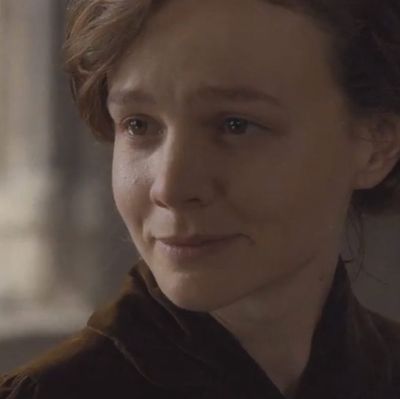
Sometimes, timeliness can be a crutch. Sarah Gavron’s Suffragette comes during a time of renewed fervor and immediacy for feminism and women’s rights, and its real-world echoes are right there with us as we watch the film. But while it may have the courage of its convictions, the movie itself often lacks depth and dimension. It feels like a lot of good, urgent ideas in search of a unifying whole.
A shame, because the film starts off providing an important angle on the issue, specifically portraying the confluence of class and gender that helped fuel the movement. It opens in 1912, in a bustling, depressing, industrial laundry, where Maud Watts (Carey Mulligan) has worked her whole life. She was born there; her mother, we later learn, worked there until her death (when Maud was 4). It may be labor, but it’s not opportunity; it’s a form of slavery, with sexual exploitation thrown into the mix as well. And yet, this is all she has known, and most likely all she will ever know.
One day, as Maud admires a shop-window display featuring models of babies and a lady in a beach chair — a world of luxury she’ll never afford — another woman passes by with a baby carriage and starts throwing rocks through the window. This is how Maud gets introduced to the world of the suffragettes — activists fighting for women’s right to vote. She’s captivated by their dedication to direct action, and soon, she’s attending secret meetings in the offices of pharmacist Edith Ellyn (Helena Bonham Carter) and hearing all about Emmeline Pankhurst (Meryl Streep, in a cameo), the founder of the Women’s Social and Political Union (WSPU), currently in hiding. The film makes it clear that, even as the need for action escalated, the suffragettes were careful about not physically harming people; they’d bomb mailboxes and even buildings, but they’d make sure there was nobody near them first.
Meanwhile, on the other side of the law, Inspector Steed (Brendan Gleeson) mounts an elaborate effort to bring down the WSPU, utilizing the latest crime-fighting tactics and camera technology. In these scenes, the film takes on the qualities of a police procedural, and there’s an intriguing idea here: the notion that women fighting for their rights would be pursued and spoken of like gangsters, or terrorists. (At one point, Steed presents to the cops descriptions and images of the different individuals they’re pursuing, and it feels like the briefings we get in action thrillers: “This is Violet Miller. She moves around a lot … and gets her hands dirty.”) The idea is good, but it’s executed in a rote manner, like a joke, so that we don’t quite grasp the harrowing nature of the irony. “We smash windows, we burn things,” one suffragette says late in the film, “because war is the only language men understand.”
The chesslike maneuvering between the authorities and Pankhurst’s foot soldiers is similarly promising but underdeveloped: If one of the suffragettes dies, we understand, it would be a political victory for the WSPU, whereas if one of the women’s targets dies, it’d be a win for the cops. Again, an idea that could be mined for tension and meaning. But the film doesn’t dwell on it other than as a way of telegraphing its climax.
Suffragette is slick and efficient, but also diffuse and formless; it’ll pass the time but it fails to engage. The previous collaboration between director Gavron and screenwriter Abi Morgan (who also wrote Shame and Iron Lady) was the 2007 Monica Ali adaptation Brick Lane, which I greatly admired, even though it was dismissed by many critics. That film found an economical way to enter Ali’s dense, sprawling narrative by focusing on just one section of the book. Suffragette shares Brick Lane’s streamlined quality — nothing feels extraneous — but lacks its focus. We keep seeing ideas and characters we wish would be explored more in-depth. It’s a movie with a lot of things to say, but walking out, you feel like you’re still waiting for it to say them.


